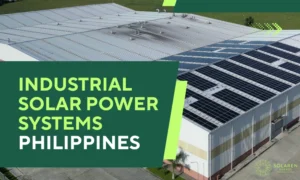Energy storage is now one of the most valuable parts of any modern solar system in the Philippines. For many homeowners, it means power that stays on during brownouts and at night. For businesses, it brings stability, lower costs, and freedom from an unreliable grid.
Batteries used to be an optional extra. Today, they are part of how solar systems are designed from the start. They help you control when and how you use your own power instead of depending entirely on the utility.
Define your goal first
Before you decide to add batteries, be clear about what you want them to achieve. Some people want backup power to keep key appliances running when the grid goes down. Others want to store solar energy during the day so they can use it at night when rates are higher. Businesses often use storage for demand control, where the battery helps flatten peaks and reduce charges from utilities.
Each purpose leads to a different design. The type of battery, its size, and how it operates all depend on your primary goal.
Understanding battery options
In the Philippines, the most common battery types are lithium-ion and lead-acid. They both work well when used correctly, but they suit different needs.
Lithium-ion, especially the LiFePO₄ type, lasts longer and handles daily charging better. It is compact, efficient, and almost maintenance-free. It costs more upfront but can be cycled every day for many years without losing much capacity.
Lead-acid batteries, including AGM and gel types, are cheaper but heavier and less efficient. They need more care and usually last only a few years. They are fine for backup systems that do not discharge often, but not ideal for daily solar use.
At Solaren, lithium-ion is the default choice for commercial and industrial systems because it offers a better return over time.
Getting the size right
Battery sizing starts with your energy use. Look at your average daily consumption and decide which parts of your load you want to cover.
If you have a five-kilowatt critical load and want eight hours of backup, you will need around forty kilowatt-hours of usable capacity plus a small safety margin. The calculation also depends on how deeply you plan to discharge the battery each cycle. Deeper discharge gives you more usable energy but shortens lifespan.
A well-sized system gives you enough backup without overspending on capacity you will never use.
Making sure it fits your solar setup
Your inverter must match your battery in both technology and voltage. Modern hybrid inverters can manage solar panels and batteries at the same time. They decide automatically when to charge, discharge, or export to the grid.
Ask your installer to show how the system prioritizes loads, schedules charging, and displays performance data. Good design lets you see real-time power flow and gives you control over where your energy goes.
At Solaren, engineers verify that each battery model communicates correctly with the inverter and that the software supports all manufacturer requirements for warranty and safety.
What to expect on cost and payback
Battery storage prices in the Philippines vary depending on size and chemistry. Lithium-ion systems usually cost between fifteen and twenty-five thousand pesos per kilowatt-hour. Lead-acid options cost less but will need replacement sooner.
Payback periods differ. A homeowner who uses batteries mainly for night power might take longer to recover the cost. A factory using batteries to avoid generator fuel or prevent lost production can see savings immediately. In most cases, the value comes from reliability as much as from direct financial return.
Maintenance and lifespan
Lithium-ion batteries typically last ten to fifteen years with almost no maintenance. Lead-acid batteries may need replacement after three to five years. Heat and poor ventilation shorten battery life, so the installation environment matters.
Check the warranty closely. Reliable brands provide both product and performance coverage, measured in years or charge cycles. Solaren systems track state of health through digital monitoring, which helps identify any performance decline early.
Safety and installation
A professional installation makes the system safe and efficient. Batteries should be placed in cool, dry, and well-ventilated spaces, away from direct sunlight and water. Proper cables, grounding, and circuit breakers protect against short circuits and overcharging.
Solaren’s technicians follow international safety codes and conduct thorough inspections before activation. This not only protects the equipment but also keeps manufacturer warranties valid.
When batteries make the most sense
Energy storage is most valuable when you face frequent brownouts or rely on consistent power for business operations. Manufacturing plants, cold storage facilities, and offices with critical equipment all benefit from uninterrupted energy.
For homes, batteries make evenings quieter and safer during storms and grid failures. Even a modest battery bank paired with rooftop solar can keep lights, fans, and refrigerators running through long outages.
Combining storage with net metering
Some people think adding batteries means they cannot export power, but net metering in the Philippines works alongside storage. You can still sell extra solar energy to the grid while keeping enough stored for your own use.
During the day, solar panels power your home or business, charge your batteries, and feed any excess to the grid. At night, your batteries provide energy, and your grid credits reduce the next bill. It is a flexible system that makes solar more profitable and independent at the same time.
Planning your next move
If you are ready to explore energy storage solutions, start with your recent electricity bills. Identify your highest consumption periods and any costs or losses from outages. Then ask a qualified installer to prepare a battery-inclusive proposal that matches your usage pattern and budget.
Evaluate each option based on lifetime value, not just the purchase price. A low-cost system that fails early or performs poorly can end up costing more than a premium setup that lasts twice as long.
With the right design and installation, renewable energy storage solutions provide flexibility, resilience, and long-term savings. Whether you are a homeowner seeking peace of mind or a business protecting production uptime, batteries help you take control of your power and your future.









